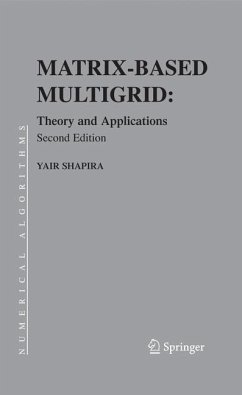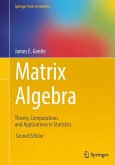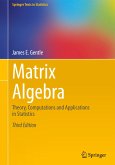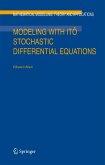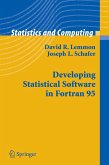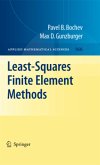Multigrid methods are often used for solving partial differential equations. This book introduces and analyzes the multigrid approach. The approach used here applies to both test problems on rectangular grids and to more realistic applications with complicated grids and domains.
Key Features of this Second Edition:
- Discusses multigrid methods from the domain decomposition viewpoint, thus making the material accessible to beginning undergraduate/graduate students
- Uses the semialgebraic multigrid approach to handle complex topics (such as the solution of systems of PDEs)
- Provides relevant and insightful exercises at the end of each chapter which help reinforce the material
- Uses numerous illustrations and examples to motivate the subject matter
- Covers important applications in physics, engineering and computer science
Matrix-Based Multigrid can serve as a textbook for courses in numerical linear algebra, numerical methods for PDEs, and computational physics at the advanced undergraduate and graduate levels. Since most of the background material is covered, the only prerequisites are elementary linear algebra and calculus.
Excerpts from the reviews of the first edition:
"This book contains a wealth of information about using multilevel methods to solve partial differential equations (PDEs). . . A common matrix-based framework for developing these methods is used throughout the book. This approach allows methods to be developed for problems under three very different conditions. . . This book will be insightful for practitioners in the field. . . students will enjoy studying this book to see how the many puzzle pieces of the multigrid landscape fit together." (Loyce Adams, SIAM review, Vol. 47(3), 2005)
"The discussion very often includes important applications in physics, engineering, and computer science. The style is clear, the details can be understood without any serious prerequisite. The usage of multigrid method for unstructured grids is exhibited by a well commented C++ program. This way the book is suitable for anyone . . . who needs numerical solution of partial differential equations." (Peter Hajnal, Acta Scientiarum Mathematicarum, Vol. 70, 2004)
Hinweis: Dieser Artikel kann nur an eine deutsche Lieferadresse ausgeliefert werden.
Key Features of this Second Edition:
- Discusses multigrid methods from the domain decomposition viewpoint, thus making the material accessible to beginning undergraduate/graduate students
- Uses the semialgebraic multigrid approach to handle complex topics (such as the solution of systems of PDEs)
- Provides relevant and insightful exercises at the end of each chapter which help reinforce the material
- Uses numerous illustrations and examples to motivate the subject matter
- Covers important applications in physics, engineering and computer science
Matrix-Based Multigrid can serve as a textbook for courses in numerical linear algebra, numerical methods for PDEs, and computational physics at the advanced undergraduate and graduate levels. Since most of the background material is covered, the only prerequisites are elementary linear algebra and calculus.
Excerpts from the reviews of the first edition:
"This book contains a wealth of information about using multilevel methods to solve partial differential equations (PDEs). . . A common matrix-based framework for developing these methods is used throughout the book. This approach allows methods to be developed for problems under three very different conditions. . . This book will be insightful for practitioners in the field. . . students will enjoy studying this book to see how the many puzzle pieces of the multigrid landscape fit together." (Loyce Adams, SIAM review, Vol. 47(3), 2005)
"The discussion very often includes important applications in physics, engineering, and computer science. The style is clear, the details can be understood without any serious prerequisite. The usage of multigrid method for unstructured grids is exhibited by a well commented C++ program. This way the book is suitable for anyone . . . who needs numerical solution of partial differential equations." (Peter Hajnal, Acta Scientiarum Mathematicarum, Vol. 70, 2004)
Hinweis: Dieser Artikel kann nur an eine deutsche Lieferadresse ausgeliefert werden.
From the reviews of the second edition:
"Shapira delivers a systematic and unified presentation of the multigrid method that is used for the efficient solution of partial differential equations. ... The notations are consistent and the presentation is self-contained. The book is recommended to readers involved in the field of computational science and engineering, from the postgraduate to the expert level. Additionally, the book is suitable for courses in numerical analysis, numerical linear algebra, scientific computing, and numerical solution of partial differential equations." (George A. Gravvanis, ACM Computing Reviews, May, 2009)
"This book provides an introduction into this area. Basically, it presupposes only a sound knowledge of analysis and linear algebra and introduces all other necessary concepts on its own. ... Many exercises are included. The presentation is well suited for seminars in this area." (H. Muthsam, Monatshefte für Mathematik, Vol. 156 (3), March, 2009)
"Shapira delivers a systematic and unified presentation of the multigrid method that is used for the efficient solution of partial differential equations. ... The notations are consistent and the presentation is self-contained. The book is recommended to readers involved in the field of computational science and engineering, from the postgraduate to the expert level. Additionally, the book is suitable for courses in numerical analysis, numerical linear algebra, scientific computing, and numerical solution of partial differential equations." (George A. Gravvanis, ACM Computing Reviews, May, 2009)
"This book provides an introduction into this area. Basically, it presupposes only a sound knowledge of analysis and linear algebra and introduces all other necessary concepts on its own. ... Many exercises are included. The presentation is well suited for seminars in this area." (H. Muthsam, Monatshefte für Mathematik, Vol. 156 (3), March, 2009)

